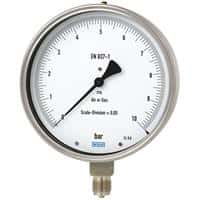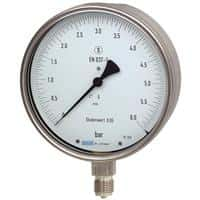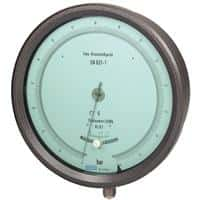Vacuum Gauges
A vacuum gauge is an instrument used to measure the pressure in a vacuum system, which is below atmospheric pressure. In other words, it measures the degree of vacuum, or the amount of negative pressure relative to atmospheric pressure, within a contained environment. Vacuum gauges are essential in various applications where creating, monitoring, and maintaining a vacuum is critical, such as in laboratories, manufacturing processes, and scientific research.
A vacuum gauge measures the pressure inside a vacuum chamber or system and displays the value in units such as millibar (mbar), Torr, microns (µm), Pascal (Pa), or inches of mercury (inHg). Depending on the type of vacuum gauge, it may work through different principles, such as mechanical deformation, thermal conductivity, or ionization of gas molecules.
Vacuum gauges come in a number of different types, including mechanical (analog), thermal condcutivity, ionization, and capacitance manometers.
Mechancial vacuum gauges include Bourdon tube vacuum gauges that utilize a curved, hollow tube that bends or straightens in response to changes in pressure, as the vacuum level increases (pressure decreases), the tube deforms, and this movement is transferred to a pointer on a dial. Bourdon tube vacuum gauges are suitable for low vacuum ranges (above 1 Torr or 1 mbar). Diaphragm vacuum gauges use a flexible diaphragm that deflects under pressure differences, this deflection is mechanically amplified and indicated on a dial. Diaphragm vacuum gauges are also used for low to medium vacuum ranges. Capsule vacuum gauges contain a sealed capsule that expands or contracts based on the pressure outside it, the movement is mechanically translated to a display. These are suitable for low to medium vacuum applications.
Thermal conductivity vacuum gauges include the Pirani gauge which operates on the principle that the thermal conductivity of gases decreases as pressure decreases. A heated wire or filament is placed in the vacuum system, and as gas molecules collide with the wire, they conduct heat away. At lower pressures, fewer collisions occur, and the wire's temperature changes. The change in resistance of the heated wire is used to determine the pressure. Pirani gauges are suitable for measuring low to medium vacuum ranges (from 10⁻⁴ Torr to 10 Torr). The thermocouple gauge is similar to the Pirani gauge, but it uses a thermocouple to measure the temperature of the heated element. The voltage generated by the thermocouple is correlated to the pressure. Thermocouple gauges are typically used for low to medium vacuum ranges (10⁻³ Torr to 10 Torr).
Ionization vacuum gauges include hot cathode ionization gauges which measures extremely low pressures (high vacuum) by ionizing the gas molecules inside the vacuum system using a heated filament (cathode). Electrons emitted from the filament collide with gas molecules, ionizing them. The ions are collected by a collector electrode, and the resulting current is proportional to the gas pressure. Hot cathode ionization gauges are suitable for ultra-high vacuum ranges (10⁻⁹ Torr to 10⁻³ Torr). Cold cathode ionization gauges are similar to the hot cathode gauge but uses a cold cathode (no heated filament) to generate electrons through a high-voltage discharge. The pressure is determined by the number of ions collected. Cold cathode gauges are also used for ultra-high vacuum measurements (10⁻⁹ Torr to 10⁻³ Torr).
Capacitance manometers or capacitance diaphragm gauges use a diaphragm that deflects in response to pressure changes, the deflection changes the capacitance between the diaphragm and a fixed electrode. This change in capacitance is measured and converted into a pressure reading. Capacitance manometers offer high precision and are used in low to medium vacuum ranges (from 10⁻⁴ Torr to atmospheric pressure).
Vacuum gauges are used in various industrial applications, such as vacuum furnaces, leak testing, vacuum forming, and vacuum impregnation, where maintaining specific vacuum levels is critical for quality and safety. They are extensively used in laboratories for experiments that require low-pressure environments, such as in vacuum chambers, freeze-drying, vacuum distillation, and surface science studies. In semiconductor fabrication, maintaining a controlled vacuum environment is critical for processes like chemical vapor deposition (CVD), physical vapor deposition (PVD), etching, and wafer processing, they ensure the desired vacuum level is achieved and maintained throughout these processes. Vacuum gauges are used in pharmaceutical and food industries for vacuum packaging, freeze-drying, and vacuum mixing processes, where a controlled vacuum environment is essential to maintain product quality and stability. In heating, ventilation, and air conditioning (HVAC) systems, vacuum gauges help monitor and maintain proper vacuum levels during installation, evacuation, and servicing of refrigerant lines and components. Vacuum gauges are used to test and maintain vacuum systems in automotive engines (like vacuum-assisted braking systems) and to ensure proper vacuum levels in aerospace applications, such as altitude simulation and space environment testing.
Vacuum gauges provide accurate measurements of pressures that are below atmospheric pressure, which is important for maintaining controlled vacuum conditions in various applications. Different types of vacuum gauges cover a broad range of vacuum levels, from low vacuum (near atmospheric pressure) to ultra-high vacuum (UHV), making them suitable for various industries and applications. Many digital vacuum gauges offer data logging, remote monitoring, and integration capabilities with control systems, enhancing process control and data analysis.


